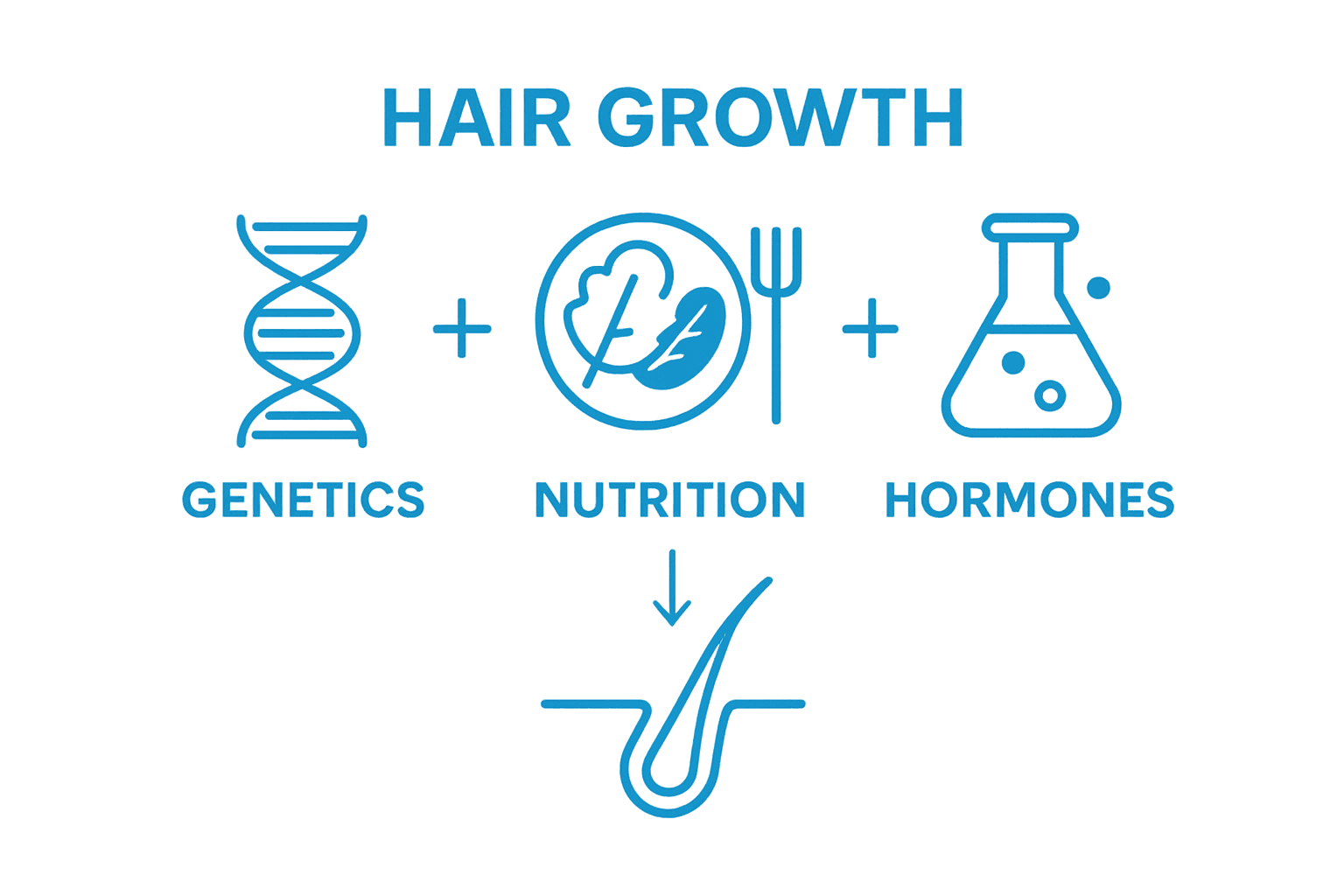Blog
Learning Materials
Understanding Hair Growth: The Science Explained
Updated: September 28, 2025

Hair growth secrets are starting to come out of the lab and into everyday life. The average human scalp holds about 100,000 hair follicles working through phases lasting years, weeks, or days. Most people think hair is about appearances or bad hair days. But the real story is that your hair is like a health report card, revealing what is happening inside your body long before any blood test ever could.
Table of Contents
- What Is Hair Growth And Why It Matters
- The Cycle Of Hair Growth: Phases Explained
- Factors Influencing Hair Growth: Genetics And Beyond
- Nutritional Needs For Optimal Hair Growth
- Common Myths And Misconceptions About Hair Growth
Quick Summary
| Takeaway | Explanation |
|---|---|
| Hair growth reflects overall health. | Patterns in hair growth can indicate nutritional status and health conditions, making it a vital health marker. |
| Understand the hair growth cycle. | The hair growth cycle consists of three phases: Anagen, Catagen, and Telogen, each essential for healthy hair development. |
| Nutritional balance supports hair growth. | Key nutrients like protein, iron, and vitamins are critical for maintaining healthy hair and preventing loss. |
| Genetics shape hair characteristics. | Genetic factors influence hair thickness, color, growth rate, and susceptibility to hair loss, determining individual hair potential. |
| Debunk hair growth myths. | Many common beliefs about hair growth lack scientific support; understanding facts helps set realistic expectations. |
What is Hair Growth and Why It Matters
Hair growth is a complex biological process that goes far beyond simple aesthetic considerations. At its core, hair growth represents a sophisticated biological mechanism revealing critical insights into our overall health and genetic potential. Research from the National Institutes of Health indicates that hair growth patterns can serve as powerful biological indicators reflecting an individual's nutritional status and underlying physiological conditions.
The Biological Foundations of Hair Growth
Understanding hair growth requires recognizing it as a cyclical process involving multiple interconnected stages. The human scalp contains approximately 100,000 hair follicles, each operating through distinct phases of growth, transition, and rest. These phases include:
- Anagen Phase: Active growth period lasting 2-7 years
- Catagen Phase: Transitional stage lasting 2-3 weeks
- Telogen Phase: Resting period before hair naturally sheds
Each hair follicle functions as a miniature biological factory, producing keratin proteins that determine hair structure, strength, and appearance. Genetic programming, hormonal signals, and nutritional inputs collectively influence these intricate mechanisms.
Why Hair Growth Matters Beyond Appearance
Hair growth is more than a cosmetic phenomenon. It serves as a critical health barometer, providing insights into systemic wellness. Abnormal hair growth patterns can signal potential underlying medical conditions such as hormonal imbalances, nutritional deficiencies, or chronic stress. Read more about tracking your hair growth progress to understand how these biological signals can inform personal health strategies.
By comprehending the science behind hair growth, individuals gain powerful tools for monitoring their overall physiological well being. Whether experiencing thinning, exploring growth optimization, or simply seeking to understand bodily processes, recognizing hair growth's intricate biological dance offers profound insights into human health and resilience.
The Cycle of Hair Growth: Phases Explained
Hair growth is not a linear process but a dynamic, cyclical journey characterized by intricate biological transitions. Research from the National Institutes of Health reveals that each hair follicle undergoes a complex sequence of stages, determining the length, thickness, and health of individual hair strands.
Understanding Hair Growth Stages
The hair growth cycle consists of three primary phases, each playing a crucial role in determining hair characteristics. These phases represent a sophisticated biological mechanism that ensures continuous hair regeneration:
- Anagen Phase: Active growth period where hair follicles produce new hair
- Catagen Phase: Transitional stage signaling the end of active growth
- Telogen Phase: Resting period before hair naturally sheds
During the anagen phase, which can last between two to seven years, hair follicles are metabolically active. This stage determines the potential length and thickness of hair, with genetics and nutrition significantly influencing growth duration.
Biological Mechanisms of Hair Regeneration
The transition between phases is controlled by intricate hormonal and genetic signals. The catagen phase, lasting approximately two to three weeks, marks a critical turning point where hair growth stops and the follicle begins to shrink. Following this, the telogen phase allows the follicle to rest before shedding occurs. Explore our expert guide on hair follicle growth to understand these complex biological interactions.
Interestingly, at any given moment, approximately 90% of scalp hair remains in the anagen phase, while 10% is in the telogen phase. This balanced distribution ensures continuous hair replacement and maintains a consistent appearance.
Here is a comparison table summarizing the three phases of hair growth and their main characteristics.
| Phase | Duration | Main Activity | Impact on Hair |
|---|---|---|---|
| Anagen | 2-7 years | Active hair growth | Determines length, thickness |
| Catagen | 2-3 weeks | Transitional phase, follicle shrinks | Ends growth, prepares for rest |
| Telogen | Few weeks to months | Resting period, hair eventually sheds | Old hairs fall, new cycle begins |
Factors Influencing Hair Growth: Genetics and Beyond
Hair growth represents a complex biological phenomenon influenced by multiple interconnected factors. Research from the National Library of Medicine reveals that genetic predisposition plays a fundamental role in determining individual hair characteristics, creating a nuanced landscape of biological potential.
Genetic Foundations of Hair Growth
Genetics serve as the primary blueprint for hair growth, dictating critical attributes such as:
- Hair thickness and texture
- Growth rate and potential maximum length
- Susceptibility to hair loss patterns
- Color and pigmentation characteristics
Specific gene variations can significantly impact hair follicle behavior, determining whether an individual will experience robust hair growth or potential thinning. The intricate genetic code acts as a comprehensive instruction manual for hair development, programming each follicle's potential and limitations.

Environmental and Physiological Influences
Beyond genetic programming, multiple external and internal factors modulate hair growth dynamics. Hormonal balance, nutritional intake, stress levels, and overall health contribute substantially to hair follicle performance. Understand the underlying reasons for hair growth challenges to develop targeted strategies for optimal hair health.
Hormones like testosterone, estrogen, and thyroid hormones play pivotal roles in regulating hair growth cycles. Significant hormonal shifts during puberty, pregnancy, or medical conditions can trigger dramatic changes in hair growth patterns, demonstrating the intricate relationship between physiological processes and hair development.
Nutritional Needs for Optimal Hair Growth
Nutrition plays a critical role in determining the health, strength, and growth potential of hair follicles. Research from the National Institutes of Health demonstrates that specific nutrients are essential for maintaining robust hair growth and preventing potential deficiencies that can lead to hair loss.
Key Nutrients for Hair Health
The human body requires a complex array of nutrients to support optimal hair growth. These essential components work synergistically to nourish hair follicles and promote healthy hair development:
- Protein: Primary building block of hair keratin
- Iron: Critical for oxygen transportation to hair follicles
- Vitamin D: Supports hair follicle cycling
- Biotin: Enhances keratin infrastructure
- Zinc: Supports hair tissue growth and repair
Each nutrient plays a unique role in hair development. Protein provides the fundamental structural component, while minerals like iron and zinc facilitate cellular processes essential for hair growth. Deficiencies in these nutrients can significantly impair the hair growth cycle, leading to thinning or weakened hair strands.
The following table outlines key nutrients mentioned in the article that are essential for healthy hair growth, along with their primary roles and impact.
| Nutrient | Primary Role in Hair Growth | Potential Impact of Deficiency |
|---|---|---|
| Protein | Builds keratin, the main structural protein | Weak, brittle hair |
| Iron | Oxygen delivery to hair follicles | Thinning, hair loss |
| Vitamin D | Supports hair follicle cycling | Disrupted growth |
| Biotin | Enhances keratin infrastructure | Brittle hair, breakage |
| Zinc | Tissue growth and repair in follicles | Hair loss, poor healing |

Dietary Strategies for Hair Nutrition
Balancing nutritional intake requires a comprehensive approach to diet and supplementation. Explore our guide on promoting natural hair growth to understand how dietary choices can impact hair health. Consuming a diverse diet rich in lean proteins, whole grains, fruits, and vegetables ensures a steady supply of critical nutrients. Additionally, staying hydrated and maintaining a balanced diet can help optimize the body's natural hair growth mechanisms, supporting both the structural and metabolic requirements of healthy hair development.
Common Myths and Misconceptions about Hair Growth
Hair growth is surrounded by numerous myths that can mislead individuals seeking accurate information about their hair health. Scientific research from dermatological studies consistently demonstrates that many popular beliefs about hair growth lack scientific substantiation.
Debunking Popular Hair Growth Misconceptions
Many widely accepted beliefs about hair growth are more fiction than fact. Common misconceptions include:
- Myth: Frequent haircuts make hair grow faster
- Myth: Stress has no impact on hair growth
- Myth: Hair loss only affects older individuals
- Myth: Wearing hats causes hair loss
- Myth: All hair growth treatments work identically for everyone
In reality, hair growth is a complex biological process influenced by genetics, nutrition, hormonal balance, and overall health. Cutting hair does not accelerate its growth rate, as hair growth occurs at the follicle level, not at the hair tip. The appearance of faster growth from regular trims simply results from removing split ends, creating a neater, healthier look.
Understanding Scientific Realities
Beyond myths, scientific understanding reveals the nuanced nature of hair growth. Learn more about natural hair growth strategies to develop realistic expectations. Factors like genetic predisposition, hormonal changes, nutritional intake, and underlying medical conditions play significant roles in determining individual hair growth patterns. What works for one person may not yield identical results for another, highlighting the importance of personalized approaches to hair health.
Take Control of Your Hair Growth Journey Today
Understanding the science behind hair growth is the first step to real change. If you have ever felt frustrated by thinning hair, confusing growth patterns, or myths that never seem to help, you are not alone. This article revealed that genetics, nutrition, and shifting biological cycles all play a crucial role in your hair’s appearance and strength. The real challenge is knowing how to apply these insights to your unique situation and track progress over time.

Ready for a smarter way to manage your hair health? MyHair.ai uses advanced AI technology to analyze your hair condition and growth patterns as explained in this guide on promoting natural hair growth. Simply upload your scan to get a detailed analysis and receive tailored product recommendations for your needs. Personalized insights are more powerful when they are designed for YOU. Do not let uncertainty hold you back from healthier hair. Visit MyHair.ai now to start tracking your results, discover what works best for your follicles, and make every step count. For more practical tips, check out how you can track your hair growth progress with confidence. Act now and embrace the future of personalized hair care.
Frequently Asked Questions
What are the main phases of hair growth?
The hair growth cycle consists of three main phases: the anagen phase (active growth lasting 2-7 years), the catagen phase (transitional stage lasting 2-3 weeks), and the telogen phase (resting period before shedding occurs).
How can nutrition affect hair growth?
Nutrition plays a crucial role in hair growth. Essential nutrients like protein, iron, vitamin D, biotin, and zinc are vital for maintaining healthy hair follicles and promoting robust hair growth. Deficiencies in these nutrients can lead to thinning or weakened hair.
What common misconceptions exist about hair growth?
Common myths about hair growth include beliefs that frequent haircuts can make hair grow faster, that stress has no impact on hair growth, and that hair loss only affects older individuals. Scientific research shows that these claims are largely unfounded.
How do genetics influence hair growth?
Genetics serve as the primary determinant of hair characteristics such as thickness, growth rate, and susceptibility to hair loss. Variations in specific genes can significantly affect how hair follicles behave and their growth potential.